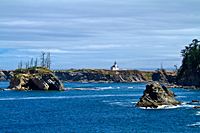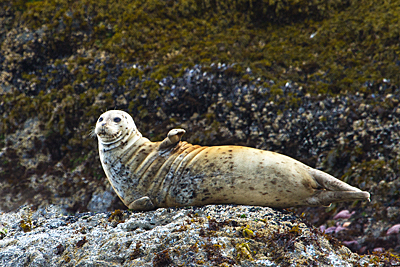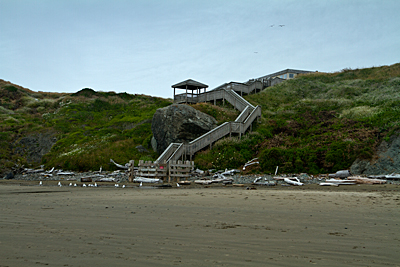It's supposed to rain tomorrow, so we're going to make a run to Bandon today and hope we have decent weather there.
Before Bandon, we wanted to photograph Cape Arago Lighthouse with the morning sun on it. If only the sun would have cooperated. The scene was drab gray when we arrived, so we took a couple of pictures and moved on to Simpsons Reef to check out the sea lions.
They have an excellent education program with volunteers with
scopes educating the visitors on the sea lions and seals
that live on Simpsons Reef.![]() The volunteers are very well-educated and seem to enjoy what they're doing. When they told us there
were elephant seals out today, we got our long lenses and tried to get something. They are going to be awfully small
in the frame, but elephant seals are cool.
The volunteers are very well-educated and seem to enjoy what they're doing. When they told us there
were elephant seals out today, we got our long lenses and tried to get something. They are going to be awfully small
in the frame, but elephant seals are cool.

As we drove back by the Cape Arago Lighthouse viewpoint,![]() we noticed the sun was now shining on the lighthouse. We made a quick U-turn and returned to the viewpoint.
We were only gone about 20 minutes, but the scene was completely different.
we noticed the sun was now shining on the lighthouse. We made a quick U-turn and returned to the viewpoint.
We were only gone about 20 minutes, but the scene was completely different.

|

|
 Then, it was down to Bandon. The farther south we drove, the cloudier the sky became. By the time we reached Bandon, everything
was socked in. Our first stop was the Coquille River Lighthouse,
Then, it was down to Bandon. The farther south we drove, the cloudier the sky became. By the time we reached Bandon, everything
was socked in. Our first stop was the Coquille River Lighthouse,![]() just across the river from Bandon. It was a small lighthouse, but it had character.
just across the river from Bandon. It was a small lighthouse, but it had character.
We had a leisurely lunch at the Wheelhouse Restaurant in Bandon. I had the best halibut I've had in a very long time. It was grilled perfectly, and it had some spice that brought out the flavor. We seem to be in prime halibut season on the Oregon coast.
We checked out the shops along the wharf and added to our collection of wind-powered birds. We bought a great pelican to go with our humming bird, blue bird, and cardinal. The guy at Tom's Crab Shack said he used to have puffins also, but he can't seem to get them now. A puffin would be very cool. We'll have to watch for one.
After lunch, we drove to the Coquille Point![]() area
to photograph. If only it had been clear weather. The area was amazing. From the cliffs overlooking the beaches,
we could see over to the jetties on the north side and down the coast to the south. In between were giant sea stacks.
They were obviously igneous in origin. Some were huge rocks that provide homes for thousands of birds.
Others looked like tortured and twisted spires where the lava had found cracks and oozed upward in the original sandstone
that was now eroded away. Several of the largest rocks had sea caves or windows. It was a low tide while we were there,
so we could walk out among several of the rock formations.
area
to photograph. If only it had been clear weather. The area was amazing. From the cliffs overlooking the beaches,
we could see over to the jetties on the north side and down the coast to the south. In between were giant sea stacks.
They were obviously igneous in origin. Some were huge rocks that provide homes for thousands of birds.
Others looked like tortured and twisted spires where the lava had found cracks and oozed upward in the original sandstone
that was now eroded away. Several of the largest rocks had sea caves or windows. It was a low tide while we were there,
so we could walk out among several of the rock formations.

|

|
There was also a colony of sea lions and seals to make the area more interesting. With the low tide, we were able to get up fairly close to them. We gave them some space so we wouldn't spook them, but we were close enough to get some "personality" shots. I have been experimenting with the movie clip capability of my 7D and even recorded a harbor seal pup moving across the rocks before it slid into the ocean.

After walking down the beach to the next point and photographing the seals and sea lions, we had one last trek. Back up the steps to the parking area.

We enjoyed the Coquille Point area, but with any kind of decent lighting, it would be the highlight of the Oregon Coast.

